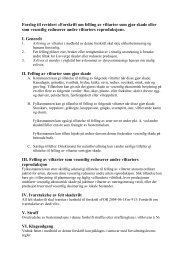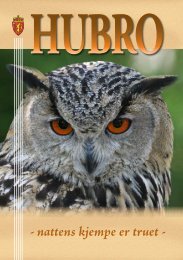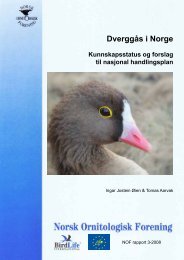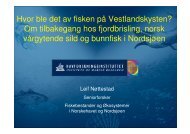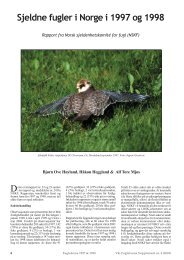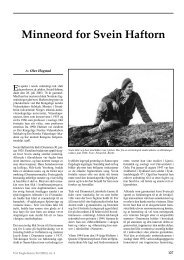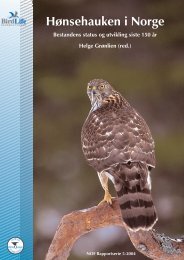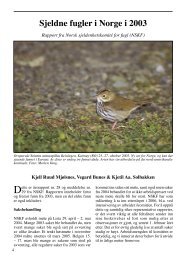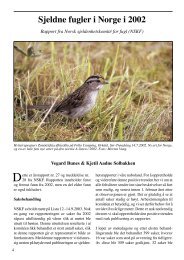Fennoscandian Lesser White-fronted Goose conservation project ...
Fennoscandian Lesser White-fronted Goose conservation project ...
Fennoscandian Lesser White-fronted Goose conservation project ...
Create successful ePaper yourself
Turn your PDF publications into a flip-book with our unique Google optimized e-Paper software.
<strong>Fennoscandian</strong> <strong>Lesser</strong> <strong>White</strong>-<strong>fronted</strong> <strong>Goose</strong> <strong>conservation</strong> <strong>project</strong> – Annual report 1999<br />
Tolvanen et al: Introduction<br />
grounds of the main part of the western populations remain unknown.<br />
A minor part – apparently not more than a few hundreds – of the western flyway birds<br />
migrate via Poland, Germany and Hungary (see e.g. Lorentsen et al. 1998, 1999) to Greece<br />
and Turkey for wintering. Out of these, less than 100 individuals presently winter in Greece<br />
(see e.g. Lampila 1998, Kazantzidis & Nazirides 1999). Approximately half of the highly<br />
endangered <strong>Fennoscandian</strong> breeding population use this flyway.<br />
The eastern flyway populations, breeding in central and eastern Siberia, from the Taimyr<br />
Peninsula eastwards, migrate to winter mainly in south-eastern China. Contrary to the situation<br />
for the western populations, the wintering areas of the eastern populations are better known<br />
than the breeding areas. Important wintering areas have been revealed during the 1990’s in<br />
China, where the East Dongting Lake being clearly the most important place at the present<br />
knowledge (see Markkola et al. 2000, pp. 9–15 in this report; Lei Gang 2000, pp. 16-17 in<br />
this report). Most of the breeding areas of the eastern populations are poorly known, but<br />
gratifyingly, an important breeding area was localised in the Indigirka River area in Yakutia<br />
during summer 1999 (Syroechkovski Jr. 2000, pp. 39-40 in this report).<br />
As a result of genetic studies on LWfG in recent years (see e.g. Ruokonen & Lumme<br />
1999, Ruokonen 2000, pp. 54–56 in this report), it has become clear that the western and<br />
eastern populations of LWfG are also genetically distinct. In addition, the genetic composition<br />
of the <strong>Fennoscandian</strong> population suggests restrictions to the gene flow with other breeding<br />
populations. Therefore, it should be conserved as a separate unit. The genetic studies have<br />
also revealed, that the captive LWfG population formerly used for reintroduction in Finland<br />
– and which is still used in Sweden – is a mixture of western and eastern mitochondrial<br />
haplotypes, and approximately 25% of the studied captive LWfG carried the mitochondrial<br />
DNA of <strong>White</strong>-<strong>fronted</strong> <strong>Goose</strong> (Anser albifrons). Therefore, the Finnish Ministry of the<br />
Environment and the LWfG <strong>project</strong> of WWF Finland decided to stop reintroduction in Finland<br />
using the current captive stock.<br />
The final goal for the LWfG <strong>conservation</strong> work is recovery of the world population and<br />
all remaining subpopulations to a sustainable level. In Fennoscandia, a viable population<br />
size would be at least some hundred breeding pairs, while the current population size is only<br />
30–50 pairs. Still, the main problem in the <strong>conservation</strong> work for the western LWfG<br />
populations – of which the <strong>Fennoscandian</strong> population is the most endangered at the moment<br />
– is the lack of knowledge about the most important staging and wintering areas south of the<br />
staging area in Kazakstan. Therefore, the main priority of the <strong>Fennoscandian</strong> LWfG<br />
<strong>conservation</strong> <strong>project</strong> is to localise and subsequently to implement <strong>conservation</strong> measures in<br />
the most important sites. As a result of our satellite tracking and ringing programmes, a very<br />
important staging area is already revealed in north-western Kazakstan, and <strong>project</strong>s aiming<br />
at conserving the most important wetlands are already under way. In the Kanin Peninsula in<br />
north-western Russia, where a stop-over site especially important for the <strong>Fennoscandian</strong><br />
population was localised in 1995 by satellite tracking, a protected area (Shoininsky Zakasnik)<br />
6<br />
Photo. Aggressive interactions between<br />
pairs of <strong>Lesser</strong> <strong>White</strong>-<strong>fronted</strong> Geese are<br />
frequent in the spring staging grounds in<br />
Fennoscandia, where the behaviour of<br />
LWfG has been studied for several years.<br />
In the wintering grounds in China conflicts<br />
between individuals were not registered at<br />
all during the time budget studies at East<br />
Dongting Lake in February 1999. © Ingar<br />
Jostein Øien, Valdak Marshes, May 1999.<br />
Photo. Risto Karvonen toasting for a<br />
brighter future for the <strong>Lesser</strong> <strong>White</strong>-<strong>fronted</strong><br />
<strong>Goose</strong> in the opening of the <strong>Lesser</strong> <strong>White</strong><strong>fronted</strong><br />
<strong>Goose</strong> exhibition in the Sami Museum<br />
Siida in Inari, November 1999 © Maija<br />
Aalto, November 1999



